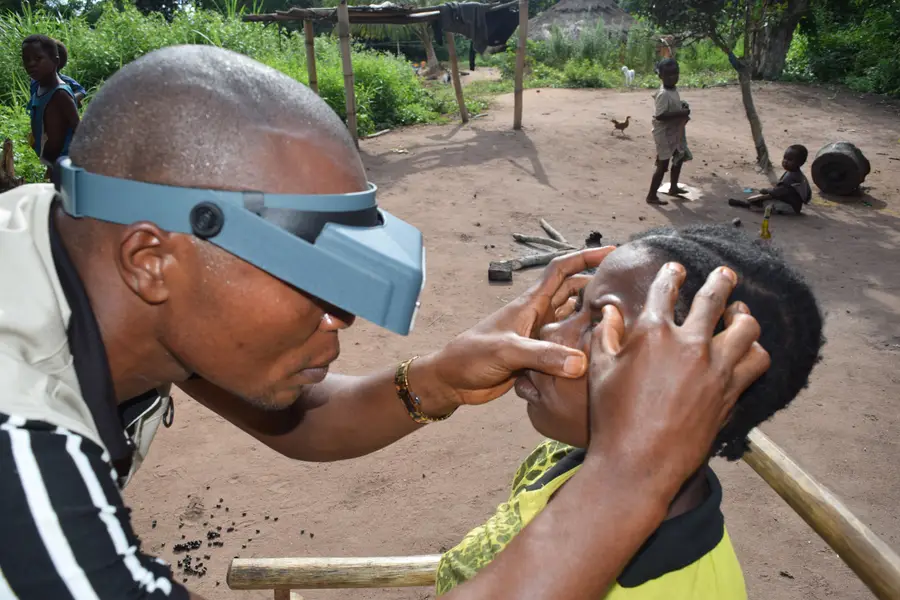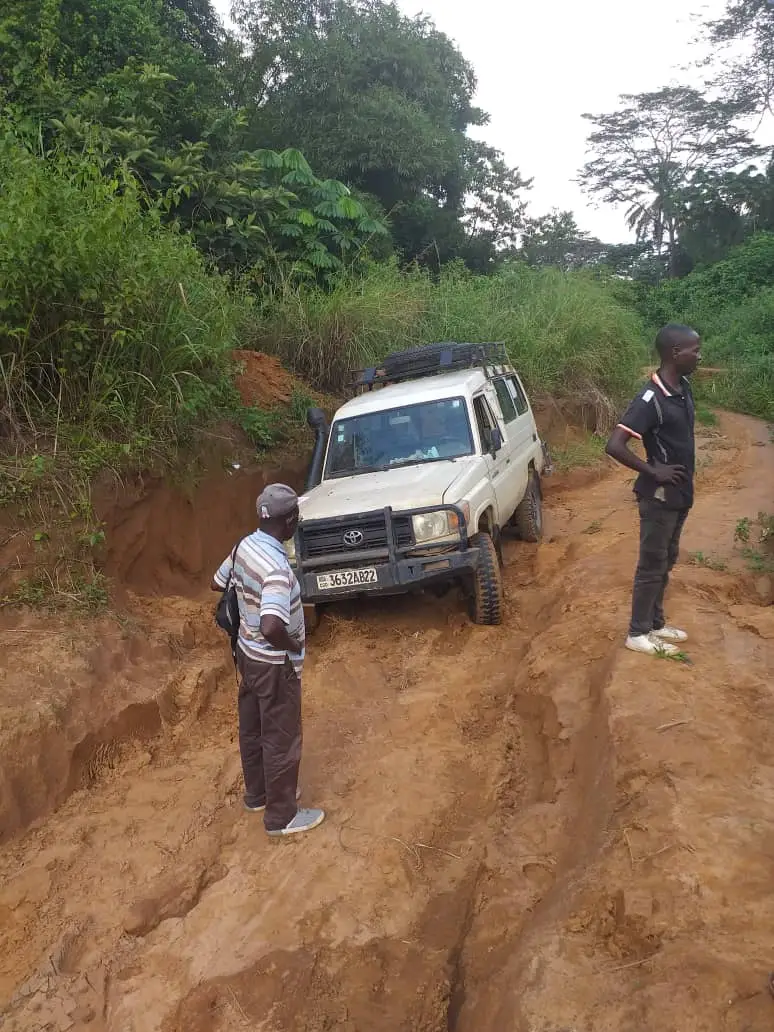
Before the COVID-19 pandemic, a trained grader uses a pair of loupes to examine a child's eyes for trachoma in DRC. Photo credit: World Vision
Since the COVID-19 pandemic hit, neglected tropical disease (NTD) experts like Dr. Jeremiah Ngondi have been focused on how to keep people safe while continuing efforts to eliminate NTDs.
This balance is particularly tricky when it comes to trachoma surveys. During a survey, trained professionals flip the eyelids of individuals to look for signs of the disease—an activity that requires reasonably close face-to-face interaction.
Now, a simple innovation has the potential to have a big impact on the global fight against trachoma, an NTD that can cause significant pain and lead to blindness.
Merging Protective Face Shields with Loupes
Dr. Ngondi’s wife is a nurse, and when he noticed her protective face shield in the back of the car, he had an idea. He started working in his garage to merge the face shield with his Optivisor loupes, a pair of magnifying glasses that surveyors use to examine eyes for trachoma.
“I used my DIY (do it yourself) skills,” says Dr. Ngondi. “I wanted to do it in the simplest way, with a design that wouldn’t fall apart and with materials that could be bought from a supermarket.”
“The magnifying glasses are really the most important part,” he continues. “We don’t want the plastic visor to be in front or behind, but to leave the visual axis completely clear.”
After consulting with his colleagues on USAID’s Act to End NTDs | East program, Dr. Ngondi settled on a design that integrated a standard transparent face shield with the Optivisor loupes—mounting and fixing the loupes directly into the shield. The detailed instruction for fabrication and assembly of the integrated loupes-face shield can be found here.

The integrated loupes-face shield design developed by Dr. Ngondi.
The integrated loupes-face shield was subsequently included in research carried out by Sightsavers and partners, in which health professionals assessed four different design prototypes. The integrated loupes-face shield was one of two prototypes selected for testing in the field because they provided one of the best combinations of visibility, convenience, comfort, cleaning, functionality, robustness, and cost.
Loupes-Face Shield Piloted in the Democratic Republic of Congo
The integrated loupes-face shield was recently piloted during trachoma surveys in the Democratic Republic of Congo (DRC).
“The DRC was a prime location to test the shield since the risk of COVID-19 transmission in surveyed areas was very low and the survey teams were very experienced,” says Mr. Raymond Stewart, Chief of Party for Act to End NTDs | East in DRC.

A surveyor in DRC uses the integrated loupe-shield to examine a man's eyes for trachoma.
Thanks to prompt and continued action by DRC’s government—informed by their experiences fighting Ebola—COVID-19 protocols are in place and guiding the country’s response. The DRC Ministry of Health also developed strict regulations for the trachoma surveys, including that all surveyors must be tested for COVID-19 before traveling to the survey area, wear a medical face mask, and check their temperatures daily.
“The loupe-face shield became icing on the cake in addition to all the other preventive measures and government actions,” says Dr. Ngondi, who did a virtual training with the team in DRC to show them how to construct the loupe-face shield. In addition to the loupes, face shields, and Velcro fasteners, fabrication requires a ruler, knife, leather punch, and flat screwdriver.
After two days of fieldwork, the survey team reported that the loupe-face shields were easy to use, comfortable to wear, did not interfere with visibility or communication, and held firmly together.

A surveyor in DRC uses the loupe-shield to examine a man's eyes for trachoma.
Based on this successful pilot, the loupe-face shield is being used for surveys in other areas of DRC, in strict accordance with COVID-19 protocols.
Efforts to Eliminate Trachoma Continue During COVID-19
Since 2014, USAID has supported the mapping of almost half of DRC’s health zones for trachoma, which provided the information needed to help the country quickly scale up mass treatment to eliminate the disease. By end of 2020, 20 out of 120 health zones had met the criteria for stopping mass treatment. Current surveys supported by USAID’s Act | East program are being done to confirm whether unmapped areas are endemic for trachoma—a key fact-finding mission on DRC’s journey to eliminate the disease.

Trachoma surveyors in the DRC face incredibly tough terrain and logistical challenges.
“The integrated loupe-face shield made it easier for our team to work in what is already one of the most difficult places to survey, even before throwing a pandemic into the mix,” says Mr. Stewart. “For this survey, for example, we were put behind schedule by 20 days because the terrain was so tough. DRC survey teams are professional and incredibly hardworking, and the shield helped make working in a pandemic as easy on them as possible.”
**
Now, the integrated loupe-shields are being used in Mozambique, while Tanzania and Uganda are planning on using them in early 2021. Surveys are being supported by the Act to End NTDs | East program with assistance from Tropical Data, a global initiative helping countries collect high-quality, standardized prevalence survey data for the elimination of trachoma.
“Global progress to eliminate trachoma must continue as safely as possible. There is too much at stake,” says Dr. Ngondi. “The updated loupe-face shield may seem like a small thing, but I hope it helps those who are bravely continuing their work, even in a pandemic, to fight for the end of this disease.”

